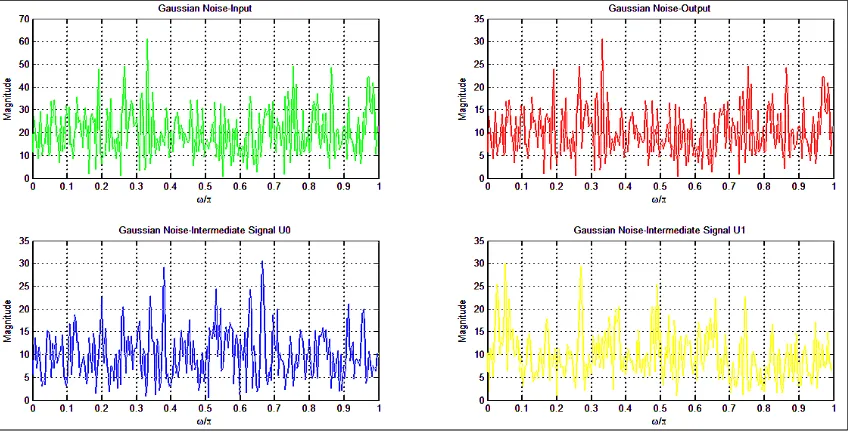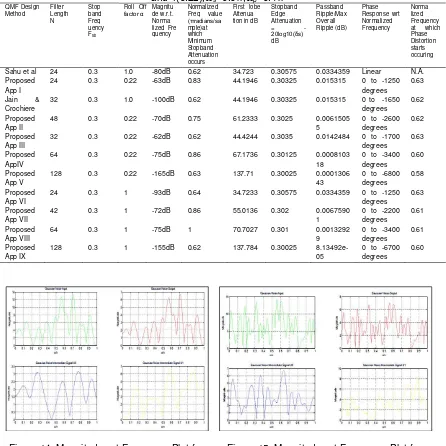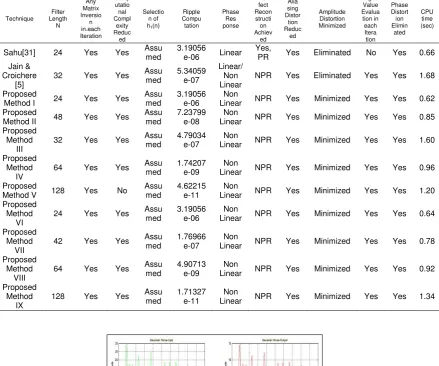DOI: 10.12928/TELKOMNIKA.v15i2.4746 636
Design and Implementation of Efficient Analysis and
Synthesis QMF Bank for Multicarrier Cognitive Radio
Communication
A. S. Kang*, Renu Vig
Department ECE, UIET, Panjab University Chandigarh. India *Corresponding author, e-mail: [email protected]
Abstract
The present section deals with a new type of technique for designing an efficient two channel Quadrature Mirror Filter Bank with constant phase in frequency. For achieving the Perfect Reconstruction Condition in Filter bank, an attempt has been made to design the low pass prototype filter with its impulse response and frequency response in three regions namely pass band, stop band and transition band region. With the error in terms of Reconstruction and the attenuation in the stop band as seen in the prototype filter response, one can evaluate the performance of the introduced filter with the help of filter coefficients generated in the design examples that affects the quality of filter bank design under the constraints of Near Perfect Reconstruction Conditions.
Keywords: analysis filter bank, synthesis filter bank, quadrature mirror filter, cognitive radio
Copyright © 2017 Universitas Ahmad Dahlan. All rights reserved.
1. Introduction
The Sensing of the available spectrum is a gigantic task in the cognitive radio systems because of Interference mitigation among different primary and secondary users is only possible by making a sacrifice of a portion from transmission bandwidth. Filter Bank Multicarrier approach can serve as a near optimal tool for spectrum analysis in cognitive radio systems with increased bandwidth efficiency attainable and decreased hardware complexity as well. Some researchers in the past have made an attempt to develop an efficient two channel Quadrature Mirror Filter banks by taking into consideration their magnitude and frequency responses in the passband, stopband and transition band regions [1]. Even, the joint effect of filters and symbols introduce various characteristics in different multicarrier schemes. The survey on wireless multicarrier communications suggests a framework to design and realize newer waveforms that not only lay the basis for further enhancements in wireless radio access techniques but also, it provides a information and ways to address different practical issues involved in the frequency domain synchronization for FBMC based Transmission. Better Spectral Containment is crucial to avoid distortion from asynchronous signals in the bands which are adjacent to each other. Also, higher spectrum is necessary while doing spectrum sensing, that is the fundamental thing in cognitive radio terminology [2].
2. FBMC System
attenuation at the analysis bank in receiver, with no pre-processing except for anti-aliasing filter estimated by the sampling rate at input in analysis filter bank. As the Filter Bank gives good frequency selection for the required spectral components, it is genuine to think of an overall receiver architecture where all the signal processing functions at the baseband are performed in the frequency [1]. FBMC Prototype Filter Design (frequency domain optimized) is an interesting direction of the future studies to investigate the overall system performance. In FBMC system, the pulses that are transmitted are localized in both time and frequency domain. A multicarrier system can be described by a synthesis-analysis filter bank called Trans multiplexer Structure [3]. The synthesis filter bank comprises of parallel transmit filters and analysis filter bank comprises of all the matched receive filters. FBMC waveforms use an advanced filter design to better localize the different subcarriers. The impulse response of the prototype filter is expressed by the following equation.
h(t)=GP(0)+2∑(-1) k
Gp (k) cos([2πk/KN](t+1)) (1)
where Gp=[1,0.97195983,0.707,1-Gp(1) 2
] for Overlapping factor K=4,6,8,10;N is the number of carriers. The higher the overlapping factor is, the more localized the signal is in frequency. In fact, the fragmented spectrum can be observed as the consequence of extension to channel aggregation for mobile communication systems [4].
Here a program is given to design a prototype filter for use in a Quadrature Mirror Filter bank. Here a two-channel filter bank has four filters, each based on a low pass prototype (�). The analysis filters are �(�), (�) while the synthesis filters are �(�), (z), �(�)= (�);
(�)= (−�); �(�)= �(�); (�)=−2 (−�) respectively.
The design procedure reduces the ripple energy and the stop band energy of the low pass filter. The design procedure is adopted by Jain-Crochiere [5] and is based on iterative cautious update optimization algorithm. When the configuration of analysis-synthesis filters is done, the overall system has an impulse response with a unit coefficient at a delay of �−1 samples. The process explained here is changed to apply a cautious update during the iteration process. This procedure uses Plot Filter command to plot the frequency responses [1].
3. Earlier Related Work Done
present section, we discuss an algorithm to design the two channel QMF bank with no matrix inversion which influences the performance of the optimization method used.
4. QMF Bank Design Methodology
The mathematical expression for the overall system function or distortion transfer function of the alias free two channel QMF bank is expressed as [21-29].
T(z)=1/2[H1 2
(z)-H1 2
(-z)] (2)
where for alias cancellation,synthesis filters are defined as:
F1(z)=H2(-z)andF2(z)=-H1(-z) (3)
To obtain the perfect reconstruction QMF bank, the overall transfer function T(z) must be a pure delay.i.e.
T(z)=(1/2)[H1 2
(z)-H1 2
(-z)]=cz-n0.or.x(n)=cx(n-n0) (4)
This equation shows that if the prototype filter H1(z) is chosen to be linear phase FIR with nil phase distortion, then to ensure linear phase FIR constraint, the impulse response h1[n] of low pass prototype filter H1(z) must be symmetrical .i.e. h1[n]=h1[N-1-n],0<n<N-1 where N is the filter length [17]. The corresponding frequency response is given by [5] as:
H1(ejω)=A(ω)e
-jω(N-1)/2
(5)
where A(ω)= H1(ejω) is the amplitude function.If the prototype flter H1(z) characteristics are assumed ideal in pass band and stop band regions then the exact reconstruction condition is satisfied for 0<ω<ωp and ωs<ω<π. Here ωp and ωs are the passband and stopband edge frequencies. The constraint comes in the transition band(ωp<ω< ωs) where Amplitude Distortion needs to be controlled. It means our motive is to optimize the coefficients of H1(z) such that the exact reconstruction condition is approximately nearly satisfied.
Design Implementation
:
A Matlab code has been run to implement the design part of prototype LPF and inference has been drawn on the basis of CPU processing time taken to run that event.The entire process here involves three steps mainly (1). Design Specification for Efficient Two Channel QMF Bank(2). Implementation of Two Channel QMF (3). Evaluation of Designed QMF results.Case Study (Design Example): We have designed the QMF here for N=24,32,42,48,64,128 with Stopband Frequency Fsb=0.359 for Alpha constant lying between 0 and 1(0.22),ωs=0.6π,ωp=0.4π. A Matlab code has been written which implements the design procedure for prototype low pass filter described and tested on a laptop equipped with an Intel Core i5-2410M Processor 2.30GHz with Turbo Boost upto 2.90 GHz with 4GB RAM on Windows 7 (64-bit) Operating system. This section presents a design example to check the effectiveness of the proposed algorithm.The main parameters which govern the performance of the algorithm are First lobe Stop band attenuation,Stop band edge attenuation, As =-20log10(H1(ωs), Maximum Overall Ripple/Passband-Ripple), Prototype QMF Length N, Stopband-Frequency(Fsb),Roll off factor Alpha, Measure of Reconstruction Error(dB)=max(10log(T(ejω))-min(10log(T(ejω)).
case of Filter (Jain & Crochiere) and subsequent set of filter coefficients obtained for O.P.Sahu et al and that obtained in case of our proposed algorithm given in Table 1,2,3, and 4.
Table 1. QMF coefficients generated [Jain & Crochiere]
Optimized Filter Tap Weights in QMF design By Jain and Croichere [N=32]at fsb=0.3;α=1
Table 2. QMF coefficients generated {Sahu et al]
Optimized Filter Tap Weights in QMF design By O.P.Sahu et al [N=24;fsb=0.3;α=1]
h1(0)=0.0034 h1(1)= -0.0074
h1(2)=-0.0022 h1(3)= 0.0163
h1(4)= -0.0020 h1(5)= -0.0301
h1(6)= 0.0124 h1(7)= 0.0525
h1(8)= -0.0375 h1(9)= -0.1000
h1(10)= 0.1272 h1(11)= 0.4672
Table 3. QMF coefficients generated [Kang& Vig-Proposed Algorithm]
Optimized Filter Tap Weights in QMF design by Kang-Vig [N=24;fsb=0.3;α=0.22]
h1(0)=0.0036 h1(1)=-0.0072
h1(2)=-0.0023 h1(3)= 0.0161
h1(4)= -0.0018 h1(5)= -0.0300
h1(6)= 0.0122 h1(7)= 0.0524
h1(8)= -0.0373 h1(9)= -0.1000
h1(10)= 0.1270 h1(11)= 0.4673
Table 4. QMF coefficients generated [Vig& Kang-Proposed Algorithm]
Optimized Filter Tap Weights in QMF design by Vig-Kang [N=32;fsb=0.3;α=0.22]
Figure 1. N=32;Fsb=0.3;Alpha=1 [Jain & Croicere] Figure 2. N=64;Fsb=0.3;Alpha=1
h1(0)=0.46513280 h1(1)= 0.13063700
h1(2)=-0.99656700E-1 h1(3)= -0.41773659E-1
h1(4)= 0.53938050E-1 h1(5)= 0.16805820E-1
h1(6)= -0.33077250E-1 h1(7)= -0.58240110E-2
h1(8)= 0.20216010E-1 h1(9)= 0.71798260E-3
h1(10)= -0.11586330E-1 h1(11)= 0.12928400E-2
h1(12)= 0.58649780E-2 h1(13)= -0.16349580E-2
h1(14)= -0.23388170E-2 h1(15)= 0.12488120E-2
h1(0)=0.0013 h1(1)= -0.0023
h1(2)=-0.0016 h1(3)= 0.0058
h1(4)= 0.0013 h1(5)= -0.0115
h1(6)= 0.0006 h1(7)= 0.0201
h1(8)= -0.0057 h1(9)= -0.0330
h1(10)= 0.0167 h1(11)= 0.0539
h1(12)= -0.0417 h1(13)= -0.0997
Figure 3. N=128;Fsb=0.3;Alpha=1 Figure 4. N=42;Fsb=0.3;Alpha=1
Figure 5. N=24;Fsb=0.3;Alpha=1 [Sahu] Figure 6. N=24;Fsb=0.3;Alpha=0.22
Figure 7. N=48;Fsb=0.3;Alpha=0.22 Figure 8. N=32;Fsb=0.3;Alpha=0.22
Figure 11. N=24,Fsb=0.3,Alpha=1 [O.P.Sahu et al]
Figure 12. Magnitude wrt Frequency Plot for (a) Gaussian Noise Input (b) Gaussian Noise Output(c)Gaussian Noise Intermediate Signal U0(d) Gaussian Noise Intermediate Signal U1 (Filter Length
N=78)
5. Results and Discussion
Table 5 shows the Performance Evaluation of Proposed Method for QMF design w.r.t QMF design by Earlier workers namely Jain & Croichere [5], Sahu et al[31]. An attempt has been made to minimize the phase distortion occurring w.r.t normalized frequency and the level of stopband attenuation occurring at different instants with variable N,Fsb and Roll off factor α. Beyond N=128 with roll off factor 1,the first lobe attenuation comes around 137.784 with passband ripple of 8.1dB and phase distortion occurring at a normalized frequency of 0.60.
Table 5. Comparatative Performance Evaluation of QMF for Design Specification N=24,32,42,48,64,128 with Stopband Frequency Fsb=0.359 for Alpha constant lying between 0
and 1(0.22),ωs=0.6π,ωp=0.4π
Figure 14. Magnitude wrt Frequency Plot for (a)Gaussian Noise Input(b)Gaussian Noise Output(c)Gaussian Noise Intermediate Signal U0(d)Gaussian Noise Intermediate Signal U1
(Filter Length N=32)
Figure 15. Magnitude wrt Frequency Plot for (a)Gaussian Noise Input(b)Gaussian Noise Output(c)Gaussian Noise Intermediate Signal U0(d)Gaussian Noise Intermediate Signal U1
Table 6. Comparison of the Proposed Algorithm with existing optimization algorithms based on
Figure 16. Magnitude wrt Frequency Plot for (a)Gaussian Noise Input(b)Gaussian Noise Output(c)Gaussian Noise Intermediate Signal U0(d)Gaussian Noise Intermediate Signal U1
(Filter Length N=128)
6. Conclusion
factor of two and ultimately passed through low pass and high pass synthesis filters. The outputs of synthesis filters are combined to obtain the reconstructed signal y(n)=x(n). The reconstructed signal suffers from errors such as Aliasing Distortion, Amplitude Distortion and Phase Distortion because of the fact that these filters are not ideal. So here, the Amplitude distortion has been minimized by optimizing the filter tap weights of low pass analysis filter. The proposed algorithm presents improved performance in terms of reduced computation time when compared to Sahu, Jain.
7. Impact of Study
The present research work has its strong impact on the design of Multirate Filter banks for cognitive radio communication under ubiquitous, pervasive domain. The study can be extended to the wireless networks through the application of efficient filter banks which can be further helpful for analysis and design of future wireless radio technologies [32-35].
References
[1] Stitz TH, Ihalainen Tero. Practical Issues in Frequency Domain Synchronization for Filter Bank Based Multicarrier Transmission. Proceedings of the IEEE International Conference ISCCSP 2008. 2008: 411-416.
[2] Sahu OP, Soni MK. Marquardt Optimization Method to design two channels Quadrature Mirror Filter Banks. Digital Signal Process. 2006; 16(6): 870-879.
[3] Dore Jean Baptise, Berg Vincent. FBMC receiver for multi-user asynchronous transmission on fragmented spectrum. EURASIP Journal on Advances in Signal Processing. 2014: 41: 1-20.
[4] Vaidyanathan PP. Multirate Digital Filters, Filter Banks, Polyphase Networks and Applications: A Tutorial. Proc. IEEE. 78(1): 56-93.
[5] Jain VK, Crochiere RE. Quadrature Mirror Filter Design in time domain. IEEE Trans.Acoust.Speech
Signal Process.1994; ASSP-32(4): 353-361.
[6] Lee TK. Automated Method for scoring breast tissue microarray spots using quadrature mirror filters and support vector machines. Proceedings of 15th International Conference on Information Fusion. 2012; 1868-1875.
[7] Xia TJiang Q. Optimal multirate filter banks: Design related symmetric extension transform and application to image compression. IEEE Trans on Signal Process.1995; 47(7): 1878-1889.
[8] Chen D, D Qu. Prototype filter optimization to minimize stopband energy with NPR constraint for filter bank multicarrier modulation systems. IEEE Transactions on Signal Processing. 2013; 61(1): 159-169.
[9] Wackersreuther G. On two-dimensional polyphase filter banks. IEEE Transactions on Acoust.Speech
Signal Processing. 1996; ASSP-34; 192-199.
[10] Chandran S. A novel scheme for a sub band adaptive beam forming array implementation using quadrature mirror filter banks. Electronic Letters. 2003; 39(12): 891-892.
[11] Sharma KK, Joshi SD. Advances in Shanon Sampling Theory. Defence Science Journal, 2013; 63(1): 41-45.
[12] Afonso VX, Tompkins WJ. ECG beat detecting using filter banks. IEEE Transactions on Biomedical Engg. 1999; 46(2): 192-202.
[13] Charafeddine H, Groza V. Wideband adaptive LMS beamforming using QMF subband decomposition for Sonar. Proceedings of8th IEEE International Symposium on Applied Computational Intelligence and Informatics. Romania. 2013; 431-436.
[14] Hara S, Masutani H. Filter bank based adaptive interference canceler for co-existence problem of
TDMA/CDMA systems. Proceedings IEEE VTS 50th Vehicular Technical Conference. 1999;
3:1658-1662.
[15] Tharan L, Yad av RP. Interference Reduction Technique in multistage multiuser detector for DS-CDMA systems. World Academy of Science, Engg and Tech. 2008; 2(8): 775-781.
[16] Johnston JD. A filter family designed for use in quadrature mirror filter banks. Proceedings of IEEE International Conference. ASSP.1999; 292-294.
[17] Andrew L, Franques VT. Eigen design of Quadrature-Mirror Filters. IEEE Trans Circuits Systems.II Analog Digital Signal Process. 1997; 44(9): 754-757.
[18] Chen CK, Lee JH. Design of Quadrature Mirror Filters with Linear Phase in the Frequency Domain.
IEEE Transactions on Circuits Systems. 1992; 39(9): 593-605.
[19] Xu H, Lu WS, Antoniu A. An improved method for the design of FIR quadrature mirror image filter banks. IEEE Transactions on Signal Processing. 1998; 46(6): 1275-1281.
[21] Nayebi K, Barnwell TP. Time domain Filter Analysis:A new design theory. IEEE Transactions on Signal Processing. 1992; 40(6): 1412-1428.
[22] Sahu OP, Soni MK, Talwar IM. Marquardt optimization method to design two channel quadrature mirror filter banks. Digital Signal Processing. 2006; 16(6): 870-879.
[23] Kumar A, Singh GK, Anand RS. An improved method for designing quadrature mirror filter banks via unconstrained optimization. Journal of Mathematical Modelling and Algorithms. 9(1): 99-111.
[24] Kumar A, Singh GK. An improved method for the design of quadrature mirror filter bank using the Levenberg-Marquardt optimization, Signal, Image, and Video Process. 2011; 7(2): 209-220.
[25] Sahu OP, Soni MK. Designing Quadrature Mirror Filter Banks using Steepest Descent Method.
Journal ofCircuits, Systems and Computers. 2006; 15(2): 29-42.
[26] Swaminathan K, Vaidyanathan PP. Theory and Design of Uniform DFT, parallel QMF banks. IEEE Transactions on Circuits Systems.1996; 33(12): 1170-1191.
[27] Rafi SM, Kumar A, Singh GK. An improved particle swarm optimization method for multirate filter bank design. Journal of Franklin Institute. 2013; 350(4): 757-759.
[28] Ghosh P, Das S, Zafar H. Adaptive Differential Evolution based design of two channel quadrature mirror filter banks for sub band coding and data transmission. IEEE Transactions on Systems, Man and Cybernetics. 2012; 42(6): 1613-1623.
[29] Upendar J, Gupta CP. Designing of two channel quadrature mirror filter bank using Particle Swarm Optimization. Digital Signal Processing. 2010; 20(10): 304-313.
[30] Jou YD. Design of two channel linear phase quadrature mirror filter banks based on neural networks.
Signal Processing. 2007; 87(5): 1031-1044.
[31] Agarwal SK, Sahu OP. Two Channel Quadrature Mirror Filter Bank: An Overview. ISRN Signal Processing. Hindawi. 2013.
[32] Kang AS, Vig Renu. Comparatative Performance Evaluation of Modified Prototype Filter Bank Multi Carrier Cognitive Radio under Constraints of Lp, K, N and D. The Computer Journal, Oxford University Press. UK. 2016;59(3): 1-13.
[33] Kang AS, Vig Renu. Comparatative analysis of Energy Detection spectrum sensing of cognitive radio under Wireless Environment using SEAMCAT. International Journal of Advanced Computer Science and Applications. USA.2016; 7(1); 493-498.
[34] Kang AS, Vig Renu. Computer Aided BER Performance Analysis of FBMC Cognitive Radio for Physical Layer under the Effect of Binary Symmetric Radio Fading Channel. Springer Journal of Wireless Personal Communications, Netherlands. 2015; 81(2): 1-15.
![Table 4. QMF coefficients generated [Vig& Kang-Proposed Algorithm]](https://thumb-ap.123doks.com/thumbv2/123dok/241806.503010/4.595.82.518.457.705/table-qmf-coefficients-generated-vig-kang-proposed-algorithm.webp)



